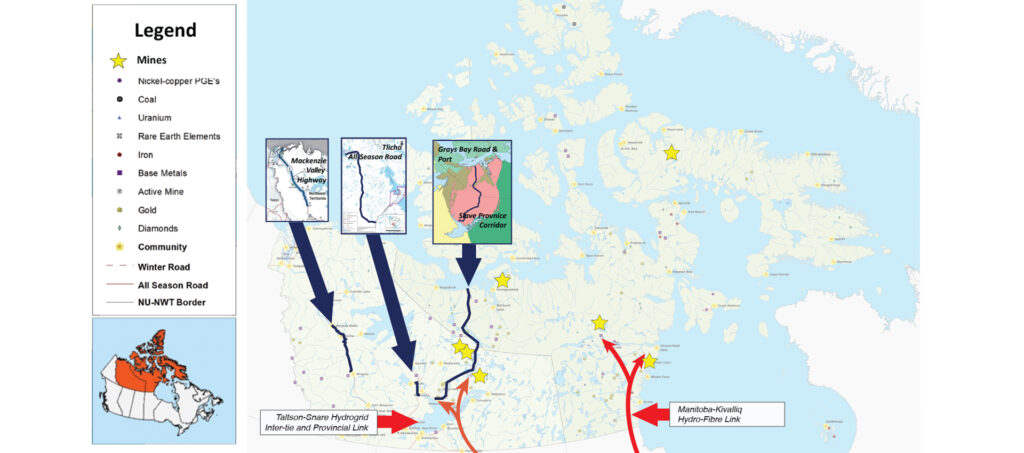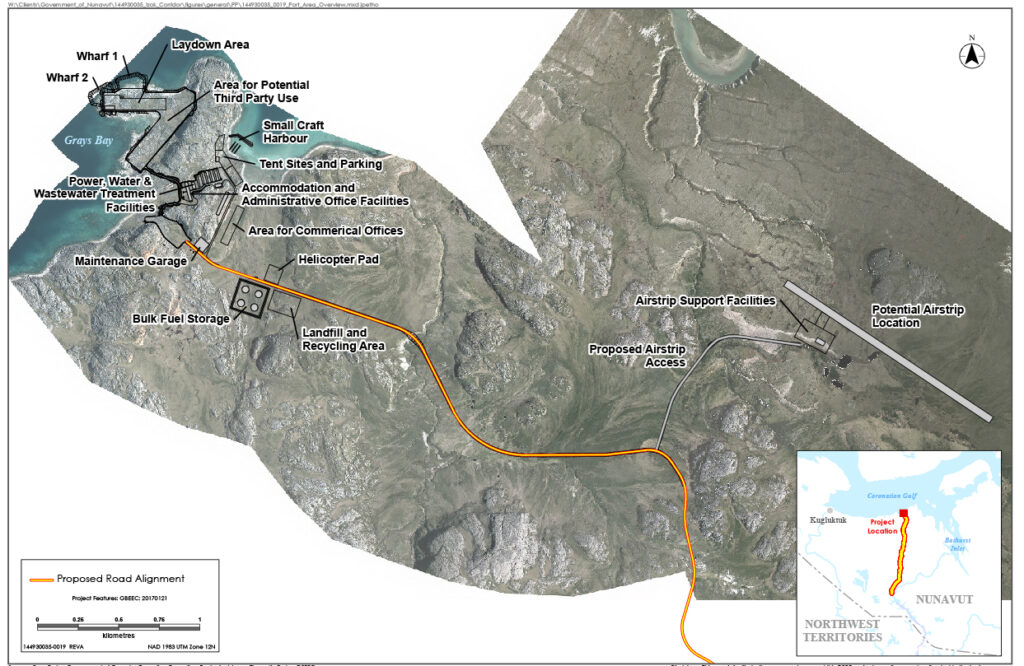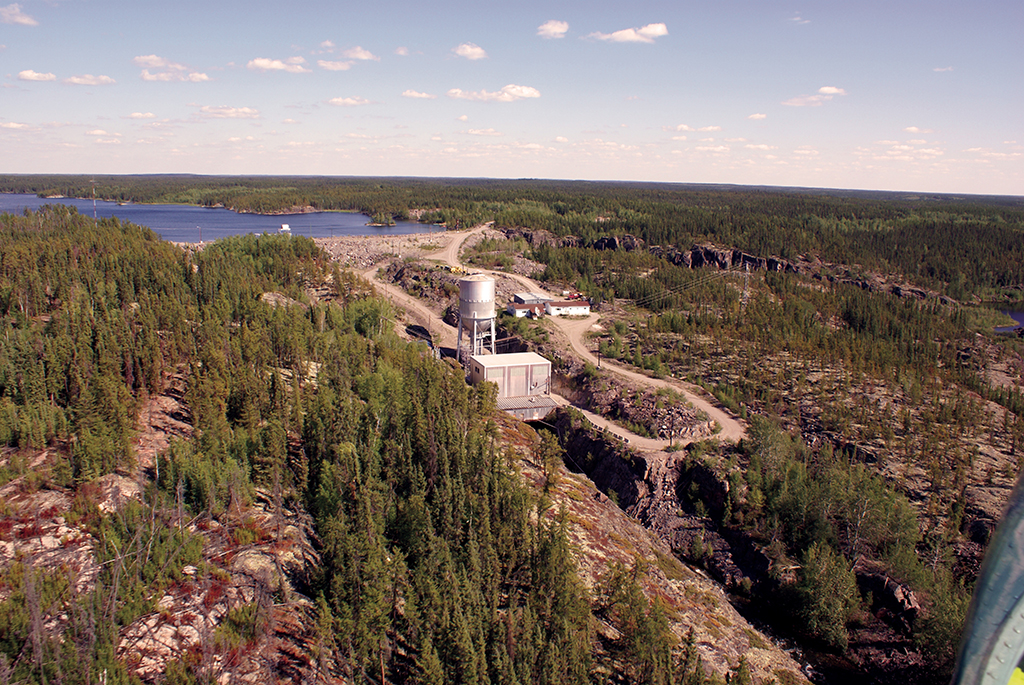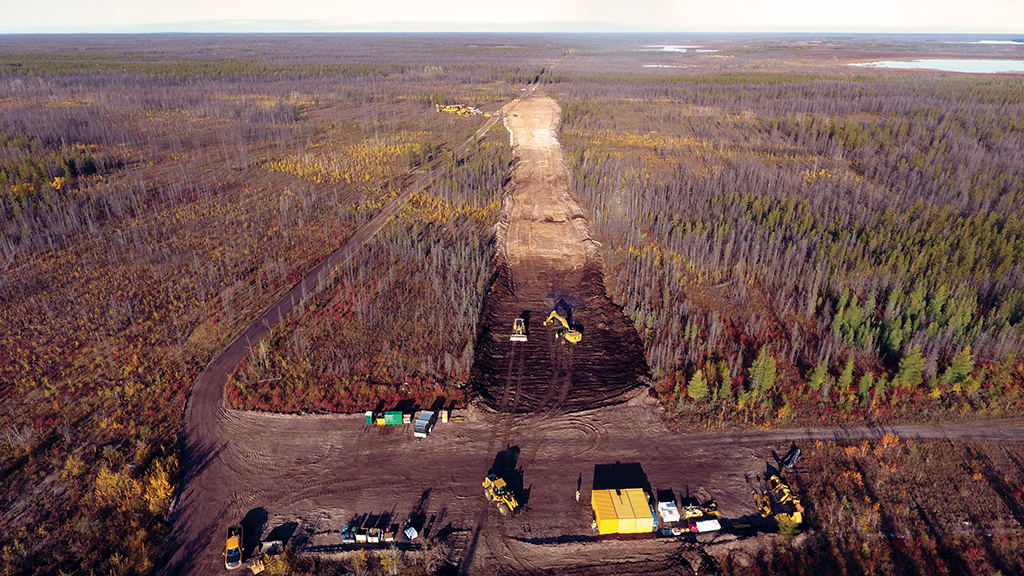
Connecting the North
With nation-building type plans for new, climate change-resistant highways, transmission lines, fibre-optic cables and deep-water ports in the works around the North, are we at the start of a golden age of Northern infrastructure development?
Northern governments have enjoyed a good run over the past decade, securing federal and/or private funds to make many critical infrastructure projects that much closer to reality.
Highways, hospitals, airports, bridges, mine cleanups and ports have sprung to life employing Northern workers and keeping resident contractors busy. Mega builds like these are becoming more critical at a time when exploration activity has been historically quiet and aging mines are looking for solutions that help lower costs and extend operating lives. Governments are working hard to keep the capacity that exists in the North busy while also ensuring a new generation is introduced to the working world through the many training programs and apprenticeship opportunities tied to these projects. Of course they bring the added benefit of improving the lives of many Northerners while also stimulating the economy and hopefully the mineral industry specifically in many cases.
Over the next decade, both the GNWT and the GN are set on continuing that trend of success in Ottawa with several other projects cued up and either shovel-ready or expected to be that way soon. Here’s a look at some of the biggest builds on the horizon.
Tłı˛cho˛ All-Season Road
First out of the chute is the Tłı̨cho˛ All-Season Road (TASR) which is now officially under construction following a ground turning ceremony this summer. The route will provide all-weather access from Highway 3 west of Behchoko to the community of Whatì with a 97-km, two-lane gravel highway. It is seen as a critical catalyst for Fortune Minerals’ polymetallic NICO mine, which is largely permitted and currently seeking financing. GNWT is working in partnership with the Tłı̨cho˛ Government to advance the project. The TASR has been funded jointly by Canada
(25 per cent) and the GNWT (75 per cent). The Project includes unique First Nations involvement, with the Tłı̨cho˛ Government taking 20 per cent equity ownership in the highway, a first for any Canadian Aboriginal group.
The highway will replace the southern section of the existing winter road helping the Tłı̨cho˛ region adapt to the impacts of climate change by providing uninterrupted access to Whatì and increased winter road access to the communities of Gamètì and Wekweètì. Transportation efficiencies will reduce the cost of living for the region and enhance social opportunities. The capital cost ceiling guaranteed through the P3 process utilized to fund, construct and operate the highway is $200 million. Construction is expected to take up to three years and will result in significant employment and training opportunities for Tłı̨cho˛ residents, supporting the development of a strong Northern workforce. The total contract value is $411.8 million over 28 years, which will be earned by North Star Infrastructure (NSI) to design, build, finance, operate and maintain the road. NSI is a consortium made up of Kiewit Canada Development Corp., and the Tłı̨cho˛ Government, with Peter Kiewit Sons ULC, Hatch Corp. and Thurber Engineering Ltd. The road is expected to officially open to traffic in 2022.
“This road will contribute to the socio-economic growth of the Northwest Territories,” says Robin Goad, President and CEO of Fortune. “It is also an important enabler for the NICO Project and a catalyst for other exploration, mining and hydro opportunities on Tłı̨cho˛ lands in this highly prospective geological area.”
Kivalliq Hydro-Fibre Link
In Nunavut, one of the projects gaining traction in recent months has been the led by the Kivalliq Inuit Association (KIA) and its partners Anbaric Development Partners as they jointly look to advance the Kivalliq Hydro-Fibre Link.

The KIA received a $1.6 million grant from the Canadian Northern Economic Development Agency to fund initial stage research required. The successful funding application will support $2.45 million in planning to review and update past feasibility work to extend renewable power and fast, reliable internet service from Gillam in northern Manitoba into Nunavut and five Kivalliq communities and both Agnico Eagle gold mines operating in the region.
“We are proud to be the development partner for the Kivalliq Hydro-Fibre Link,” said Clarke Bruno, President of Anbaric’s transmission group. “The project aligns well with Anbaric’s corporate mission, which is to create electricity system efficiencies by linking markets, to promote the trade of renewable power, and to work with local champions.
“The KIA represents the seven communities of the region, has a long-term point of view and is committed to this infrastructure solution. With this support from the Government of Canada, our partnership is poised for success in Nunavut.”
Currently the projected cost is $1.2 billion. The studies will look at the feasibility of a main 230 Kilovolt, up to 1,200 kilometres of electric transmission line, several shorter medium voltage transmission lines, and a fibre optic line.
“Renewable energy, sustainable economic development, and high-speed fibre optic internet are priorities for our communities,” says David Ningeongan, President of KIA.
The Kivalliq Hydro-Fibre Link is expected to translate into $40 million in annual savings from diesel costs and lower the Qulliq Energy Corp.’s energy supply costs by half. It could result in
$60 million in similar savings for the mining industry potentially extending the lives of existing mines.
The switch from diesel to hydro in those five Kivalliq communities and two mine sites would eliminate 380,000 metric tonnes of greenhouse gas emissions each year. And the provision of fibre optic will also make internet speeds 3,000 times faster than they are in some cases today.
Grays Bay Road and Port
On the western edge of Nunavut, MMG Limited welcomed the commitment from the Canadian National Trade Corridors Fund this summer of $21.5 million for the design, permitting and development of the Grays Bay Road and Port (GBRP) Project. The funding from the Canadian Government’s National Trade Corridors Fund will be used to advance the design, permitting and feasibility of the project to ‘shovel-ready’ stage. The road and port represent critical infrastructure to open up access to the Greenstone belts of the Slave Geological Province, which host MMG’s Izok and High Lake deposits. The funding adds to the $7.25 million already committed by Nunavut Tunngavik Inc (NTI).
“On behalf of MMG, I would like to extend my sincere thanks to the Canadian Government for committing their support and funding and my congratulations to the Kitikmeot Inuit Association and all the people of Nunavut on this announcement”, said MMG CEO Geoffrey Gao. “Road and port access is the key to unlocking the Izok Corridor, hosting some of the world’s most attractive undeveloped zinc and copper deposits. Together, the Grays Bay Road and Port and the Izok Corridor Project, could bring tremendous opportunities for Canadians to build and operate these projects, and will enhance economic growth and social development in Nunavut and the Northwest Territories.”

The plan would see the mineral-rich Slave Geological Province, which straddles Nunavut and the NWT, connected to Arctic shipping routes via a 232-km all-season gravel road and a deep-water port at Grays Bay on the Coronation Gulf.
If advanced, construction would likely run throughout the year over a four-year period.
“In addition to the road and port, the project will require construction of bridges and culverts, quarries, tanks for storing diesel fuel, a runway, a rest station at Jericho Mine and other facilities needed to operate a port, such as a landfill, camp, power supply and sewage treatment,” wrote Paul Emingak, KIA’s executive director, in the proponents’ official submission to the Nunavut Impact Review Board (NIRB).
A project of this scale obviously wouldn’t come cheap and current estimates for the GBRP are pegged at $487.5 million. This includes final planning, engineering and environmental studies at $12.5 million; general mobilization and demobilization at $39 million; materials and supplies at $65 million; on-site work $286 million; and a contingency of
$85 million.
It also works out roughly to $400 million for the highway and $87.5 million for the port. The proponents say that would be money well spent given the numerous benefits resulting from construction of the GBRP. These are expected to include:
Boosting Canada’s gross domestic
product (GDP) through infrastructure-induced Northern resource development – just the development of MMG Canada’s Izok Corridor Project, in concert with construction of GBRP infrastructure will, over a 15-year period, raise Nunavut’s GDP by a total of $5.1 billion and Canada’s by $7.6 billion;
• Stimulating new mineral exploration and development;
• Supporting the economies of the NWT, Alberta and other jurisdictions;
• Generating significant amounts of employment for Northern residents;
• Strengthening Northern sovereignty, safety and security;
• Connecting Nunavut to the rest of Canada and the world;
• Providing Nunavut communities with access to markets via a new overland route;
• Reducing the cost of living in western Nunavut communities;
• Providing cost-effective and climate change resilient transportation options for diamond mines in the NWT – potentially extending their operating lives; and,
• Connecting Yellowknife businesses with shorter access to tidewater.
For most Inuit, the biggest boost would likely come in the form of long-term, stable good-paying jobs.“Up to 250 people at any time, working on fly-in/fly-out rotation schedules, will be required to build the project,” added Emingak.
“During operations, the number of required employees will be much less than during construction – between 10 to 25 positions … We will develop and apply an Inuit hiring policy to maximize opportunities for Inuit during and after construction.”
The project will support training of Inuit for jobs such as in administration, equipment operation, camp services, emergency response and port operations, he added.
Slave Geological Province Corridor
Linking the southern section of the KIA’s planned GBRP to the existing NWT highway network is the GNWT’s proposed Slave Geological Province Corridor (SGPC), which will support road access, hydro transmission lines and communications infrastructure into the same area of significant mineral potential.
A two-lane gravel infrastructure corridor some 413 km in length, the projected cost of the SGPC is currently estimated at $1.1 billion. While that seems like a lot, consider that the historic value of production (2018 dollars) from mines within the 213,000-sq-km SGP is $45 billion.
All-weather access would support a green economy by also enabling development of the Taltson Hydro Expansion and Transmission Line project. It would also encourage more mining activity including potentially the production of base and precious metals required for low-carbon technologies.
In August it was announced the project would receive $40 million to support environmental regulatory reviews and planning studies required to bring it to shovel-ready status.
Transport Canada will contribute $30 million under the National Trade Corridors Fund and the GNWT will contribute $10 million. The SGPC has significant untapped mineral potential including several defined large base metal deposits and hundreds of base metal and gold showings (372 along current proposed route alone).
Taltson Hydro Expansion
As mentioned previously, tied to the SGPC is the Taltson Hydroelectricity Expansion Project. It would expand the existing Taltson generating station and connect the NWT’s hydroelectric systems to provide clean energy to the mineral-rich Slave Geological Province.
The Taltson River system has 200 MW of electrical generation potential.
A 60 MW expansion of Taltson could remove 240,000 tonnes of GHG emissions annually. Additionally 270 km of transmission lines would be built to connect Taltson to the North Slave hydro system.

The GNWT also hopes to connect the NWT electrical grid to the Southern provincial electrical grid to enable hydro exports. Increased generation capacity would help stabilize electricity rates for NWT residents
and businesses. The project would provide partnership opportunities for Indigenous governments and job opportunities for Northerners. The 60 MW run-of-the-river expansion project would have no new flooding, minimizing environmental impacts.
Approximately $2 million in federal funding was secured in late 2018 to review and update past feasibility work, and support partnerships with Indigenous governments. The Government of Canada committed $18 million over three years to the project in the 2019 federal budget. Work is underway to develop transmission and hydro plans, fulfill environmental responsibilities, engage stakeholders, and establish strong Indigenous partner relationships.
Mackenzie Valley Highway
The other NWT mega-project in the works is the long-sought-after completion of the Mackenzie Valley Highway (MVH), which would
connect the southern parts of the territory to the Arctic Coast. MVH investments to date have included the federal and territorial governments investing over $145 million since 2000 not including the Inuvik-Tuk Highway. Some 40 of 42 permanent bridges and stream crossings have been constructed.
In November 2017, the $200-million Inuvik Tuktoyaktuk Highway opened and received 15,000 travelers in its first year. This has already increased tourism and allowed for permafrost research. The Canyon Creek Access Road opened a year later. This 14-kilometre access road south from Norman Wells runs along the MVH alignment. It allowed for increased capacity for residents to take advantage of future construction of the larger highway.
While the total project remains the eventual goal, today the GNWT is focused on a pared-back version from Wrigley to Norman Wells. A two-lane gravel highway, it would be 321 kilometres in length. The estimated cost is pegged at $700 million.
While several regulatory hurdles remain, currently the GNWT’s best estimate on the potential start of construction is September 2024. MN

